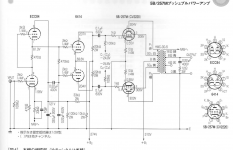In general - no (6N15P has common cathode to begin with).
In some specific application - might be.
In some specific application - might be.
What characteristics would make an "OK sub"? The 6414 is a computer tube so any tube that turns on and off meets that functional requirement. What are your requirements?
I should have been more specific
I have some CV391 tubes and a pair of 5K OPTs so I thought I might build one of the Japanese amps Soundhappy has posted, see attached. I already have a line on some Russian ECC84 equivalents but I'm open to suggestions for other sources.
Thx, Steve
I have some CV391 tubes and a pair of 5K OPTs so I thought I might build one of the Japanese amps Soundhappy has posted, see attached. I already have a line on some Russian ECC84 equivalents but I'm open to suggestions for other sources.
Thx, Steve
Attachments
Help understanding
Presumably, if they are computer tubes, matched triodes are not going to be so easy to find for the common cathode/LTP phase splitter.
Please can someone help me understand the relationship between the mu-follower input stage and the phase splitter. I don't see the purpose of the 0.22uF capacitor from the top anode of the mu-follower.
Presumably, if they are computer tubes, matched triodes are not going to be so easy to find for the common cathode/LTP phase splitter.
Please can someone help me understand the relationship between the mu-follower input stage and the phase splitter. I don't see the purpose of the 0.22uF capacitor from the top anode of the mu-follower.
The schematic is not the easiest to read. I prefer to put the high voltage on top and ground at the bottom, helps me understand current flow.
This is the obligatory SRPP input, directly coupled to an LTP.
The 22nF on the grid of the other LTP triode is the decoupling to ac ground. In this case there are two: one to ground and the other to the HT feeding the SRPP, also an ac ground. Any residual hum on the HT (devided by the two 22nF caps) is applied to the grid in opposite phase. It could help reduce hum a bit.
This is the obligatory SRPP input, directly coupled to an LTP.
The 22nF on the grid of the other LTP triode is the decoupling to ac ground. In this case there are two: one to ground and the other to the HT feeding the SRPP, also an ac ground. Any residual hum on the HT (devided by the two 22nF caps) is applied to the grid in opposite phase. It could help reduce hum a bit.
First, it's not a µ-follower but a SRPP, gives a gain (unloaded) of µ/2 with the lower cathode unbypassed.Presumably, if they are computer tubes, matched triodes are not going to be so easy to find for the common cathode/LTP phase splitter.
Please can someone help me understand the relationship between the mu-follower input stage and the phase splitter. I don't see the purpose of the 0.22uF capacitor from the top anode of the mu-follower.
The two capacitors give a divide by two of the hum/noise on the supply as does the middle of the SRPP, sort of cancellation on the phase splitter.
Mona
- Home
- Amplifiers
- Tubes / Valves
- Substitute for 6414 tube?
